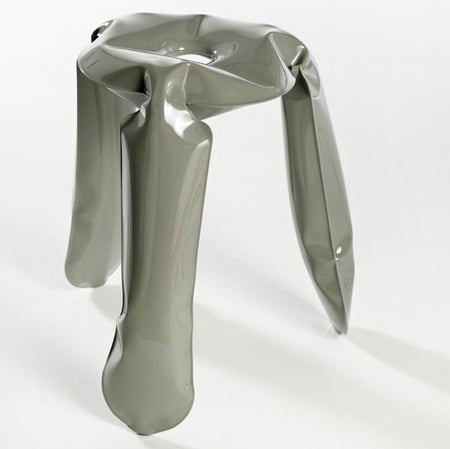Polish designer Oskar Zieta has designed a metal stool called Plopp for Danish furniture brand Hay.
The stools are made from hydro-formed metal; two sheets of metal are welded together following the outline of the stool, which is then filled with fluid under pressure.
The legs of the stool are then bent into place, creating a form that Zieta likens to inflatable furniture.
"The result is a light construction which can be easily mass-customized at low production costs with well established techniques," says Zieta.
The following is from Hay:
--
The stool PLOPP designed Oskar Zieta for HAY
Idea: The idea was to produce a stable and convenient furniture out of thin metal sheets using the potential of hydro-formed metal surfaces.
This was achieved by placing welds along the outer contour line and the interior. The interior welds as well as the pressure of the poured in fluid applied limits and control to the formation of interior cushions, creating the final shape resembling the pattern on the BlowUp Furniture.
The result is a light construction which can be easily mass-customized at low production costs with well established techniques.
Novelties of the process:
- industrial production with a unique result
- every single furniture is a unique sculpture
- combination of creative freedom with a consistent production process
- creation of a handmade expression produced by CNC machines
- unlike other CNC manufactured products with identical expression, PLOPP looks like a one-off handmade product
- application of modern techniques and materials for a retro futuristic design
- combination of stability with minor production effort and simplicity resulting in an appealing look.
Production process: PLOPP can be manufactured with different metals like steel, chromium-nickle steel and various alloys.
First the metal sheets are welded together at the contour of the final shape. The following application of a spot-welding raster is essential for later forming processes.
This grid is depending on the overall dimensions of the stool. The hydro-forming process applies liquids with high pressure to the water-tight welded inner space.
This pressure and the thickness of the metal sheets define the 3D appearance and stability of the stool. In the last step bends are applied to the inflated shape, thereby folding the stool into its final form.
More about Hay on Dezeen:
.

